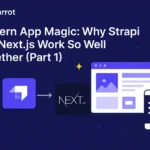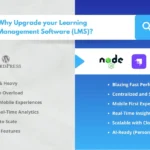Welcome back! In Part 1 of this series we introduced the powerful combination of Strapi (your modern content hub) and Next.js (your super-fast frontend builder). We saw how they individually shine and got a first look at why they’re a dream team, especially for businesses looking to escape the limitations of outdated applications.
Now, let’s really get into the nitty-gritty. We’ll start by exploring the compelling reasons and tangible benefits of migrating older applications to this modern stack. Then, we’ll dive deeper into the synergistic advantages of Strapi and Next.js, look at how to get started, and share some pro tips for making your app a search engine superstar.
Breathing New Life into Old Apps: The Migration Advantage with Strapi and Next.js
Is your business currently relying on an application that feels like it’s from a bygone era? Slow, difficult to update, clunky on mobile, and maybe even a security concern? You’re not alone. Many businesses face this. Migrating to a modern stack like a Strapi and Next.js isn’t just a facelift; it’s a fundamental upgrade that brings a wave of benefits for both your customers and your bottom line.
How Your Customers (End-Users) Win with Migration
Imagine your customers using your old app – probably a bit slow, maybe it doesn’t work well on their phone, and finding information is a chore. Now, picture their experience after migrating to Strapi and Next.js:
- Warp-Speed Experience: Pages load in a blink. Clicking a product on an e-commerce site built with Next.js feels instant, compared to the 5-10 second wait they endured before. This drastic reduction in load time (thanks to Next.js’s rendering magic) means less frustration and more happy Browse..
- Sleek, Modern, and Easy to Use: Next.js enables developers to build beautiful, intuitive interfaces. Instead of a cluttered, confusing old design, users get a clean, modern layout that’s easy to navigate, whether they’re tech-savvy or not. Finding what they need becomes a breeze..
- Works Perfectly on Any Device: Tracking student progress, engagement, and course completions becomes challenging without modern analytics.
- Cool New Features, Faster: Modern architecture makes it easier for your team to add new, exciting features that users will love – perhaps a better search function, personalized recommendations, or easier ways to interact.
- More Reliable, Fewer Glitches: Modern codebases, built with best practices, tend to be more stable. This means fewer frustrating crashes, bugs, or weird errors that plagued your old application..
The TechParrot Solution: Modern, Scalable, AI-Ready LMS
At TechParrot, we specialize in upgrading outdated educational platforms into modern, efficient, and future-proof learning systems tailored for today’s dynamic learning needs.
Custom Web Development
- Next.js and Node.js: Replace slow WordPress platforms with custom-built solutions leveraging Next.js and Node.js for exceptional speed, improved SEO, and enhanced user engagement.
- Responsive Mobile-First Design: Ensure consistent user experiences across all devices, significantly enhancing learner engagement and satisfaction.
Powerful and Flexible LMS Implementation
- Strapi CMS: Deploy a secure, centralized content management system to simplify course and content management.
- AWS Integration: Use AWS S3 and EC2 for robust video hosting, secure backups, and scalable computing resources.
- Real-Time Learner Insights: Integrate xAPI and SQLLRS for accurate tracking of learner interactions, enabling personalized learning experiences and optimized content delivery based on actual usage data.
AI-Ready and Future-Proof
- Built for AI Integration: Our platforms support emerging educational trends such as personalized learning paths, adaptive feedback, sentiment analysis, and advanced predictive analytics.
- Centralized Data Management: Consolidate user and course data for streamlined operations and compliance with global standards like GDPR.
The Business Payoff: Why Modernization with Strapi and Next.js Makes Financial Sense
Upgrading isn’t just about making things look pretty; it’s a smart business move with real, measurable returns:
- Boost Your Revenue & Growth:
- Skyrocketing Conversion Rates: This is a big one. When your site is fast and easy to use, more visitors complete desired actions – like making a purchase, signing up, or filling out a form. Real-world example: An e-commerce business, “Global Widgets Inc.,” migrated their slow, outdated online store to Strapi and Next.js. They saw a 30% increase in completed checkouts within three months, simply because product pages loaded almost instantly and the cart process was streamlined. This directly translated to a significant revenue uplift.
- Happier Customers Stick Around (Improved Retention): A great user experience builds loyalty. If customers enjoy using your app, they’re more likely to come back and recommend you to others.
- Tap into New Opportunities: A flexible, modern platform allows you to quickly adapt to market changes or launch new digital products and services, opening up new revenue streams
- Slash Operational & Maintenance Costs:
- Less Time (and Money) on Maintenance: Old systems are often a nightmare to maintain, requiring specialized (and expensive) knowledge. Modern codebases built with Strapi and Next.js are generally cleaner and easier for developers to work on. Example: “Legacy Corp” was spending nearly 40% of its IT budget on just keeping its old customer portal running. After migrating to Strapi / Next.js, their maintenance costs dropped by over 50% in the first year because fewer things broke and updates were simpler.
- Smarter Infrastructure Spending: Old apps often run on bulky, expensive servers. Next.js sites can often be deployed on cost-effective “serverless” platforms (like Vercel or Netlify) that scale automatically. Strapi can also be hosted efficiently. This means you pay for what you use, not for idle server capacity.
- Fewer Emergency Fires to Put Out: A stable, modern app means your tech team spends less time dealing with unexpected crashes and more time building valuable new features.
- Fortify Your Security:
- Modern Defenses: Legacy systems often have known security holes that are no longer patched. Strapi and Next.jsare built with current security best practices. The decoupled nature (Strapi backend separate from Next.js frontend) also reduces the attack surface.
- Example: A financial services firm using an old portal was constantly worried about data breaches. Migrating to Strapi (for secure content/data APIs) and Next.js (for a secure frontend) allowed them to implement modern authentication and significantly reduce their vulnerability to common web attacks.
- Become More Agile and Innovate Faster:
- Speedy Feature Development: With a modern stack, your developers can build, test, and deploy new features much more quickly. Example: “Innovate Solutions Ltd.,” a SaaS company, struggled to release more than one major update a year for their old platform. Post-migration to Strapi / Next.js, their development cycles shortened dramatically, allowing them to roll out significant new functionality every quarter, keeping them ahead of competitors.
- Easy Integration with Other Modern Tools: Need to connect to a new payment gateway, analytics service, or marketing automation tool? Modern APIs in Strapi and the flexibility of Next.js make these integrations much smoother than trying to bolt new services onto an old system.
- Enhance Your Brand Image and Build Trust:
- A fast, sleek, modern application signals to your customers that your business is current, professional, and cares about their experience. An outdated app can make you look, well, outdated. First impressions count!
- Widen Your Reach with Better Accessibility:
- Modern web development tools and practices make it easier to build applications that are accessible to people with disabilities (e.g., those using screen readers). This is not only the right thing to do but also expands your potential customer base.
Migrating from an outdated application to Strapi and Next.js is an investment in your business’s future – leading to happier customers, a healthier bottom line, and a more agile, secure, and innovative operation.
The Strapi + Next.js Synergy: More Reasons It’s a Winning Formula (Beyond Migration)
Even if you’re starting fresh, the combined strengths are compelling:
- Happier, More Productive Developers:
- Teamwork Makes the Dream Work: Different parts of your development team can work on Strapi (backend content) and Next.js (frontend design) at the same time.
- Result: Your app gets built faster, and your development team can focus on innovation.
- Scales Up Without Breaking a Sweat:
- Handles More Visitors Easily: As your app grows in popularity, you can scale the Strapi backend and Next.js frontend independently and cost-effectively.
- Result: Your application can grow with your business and handle busy periods smoothly.
- Ready for the Future (Future-Proofing):
- Adapt to New Tech: Your valuable content in Strapi remains safe even if you decide to change your frontend technology from Next.js to something else years down the line.
- Result: You protect your investment and can keep your app feeling modern.
Getting Your Hands Dirty: A Simple Guide to Starting with Strapi and Next.js
- Set Up Strapi (Your Content Kitchen):
- Install Strapi.
- Design your “Content Types” (e.g., “Products” with fields for name, price, image; “Articles” with title, body, author).
- Add some content.
- Make the content available via Strapi’s auto-generated API.
- Build with Next.js (Your Display Window):
- Set up a new Next.js project.
- Write code to fetch data from your Strapi API.
- Design your pages and components in React to display this data beautifully.
- Putting it Online (Deployment):
- Strapi: Host on Strapi Cloud, a VPS, or other cloud platforms.
- Next.js: Platforms like Vercel or Netlify are excellent and optimized for Next.js.
Supercharge Your Google Rankings: SEO Tips for Strapi & Next.js
- Speed is Key: Next.js’s fast performance is a direct SEO benefit.
- Organize Content for SEO in Strapi: Use fields for SEO titles, meta descriptions, and keywords. Next.js will use this data.
- Optimize Images: Use Next.js’s <Image> component and provide descriptive “alt text” in Strapi.
- Create a Sitemap: Next.js can generate a sitemap from your Strapi content.
- Internal Linking: Connect related content within Strapi.
- Mobile-Friendliness: Next.js excels at this.
- Use Analytics: Track what works and refine.
What Can You Build? Inspiring Examples
- E-commerce Sites: Blazing-fast product catalogs, seamless checkouts.
- Marketing Websites & Landing Pages: High-converting, engaging experiences.
- Corporate Portals & Intranets: Modernizing internal communications.
- Online Learning Platforms: Smooth delivery of educational content.
- Publisher Websites: Fast-loading articles and rich media experiences.
Conclusion: Build Smarter, Not Harder, with Strapi and Next.js
Whether you’re looking to escape the shackles of an outdated application or starting a brand-new digital venture, the Strapi and Next.js combination offers a path to success. It empowers you to build applications that are fast, user-friendly, SEO-optimized, scalable, and secure.
By modernizing your tech stack, you’re not just updating software; you’re investing in better customer experiences, increased revenue potential, reduced operational headaches, and a more agile future for your business.
Ready to transform your online presence and reap the benefits of modern technology with Strapi and Next.js? TechParrot specializes in migrating legacy systems and building cutting-edge digital solutions. Our expert team can guide you through every step, from strategy and development to deployment and optimization, ensuring your application is built for today’s demands and tomorrow’s opportunities.
Talk to TechParrot Today – Let’s Discuss Modernizing Your Application and Unlocking Your Business Potential!








